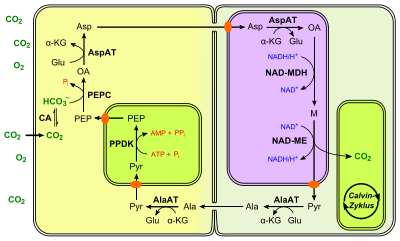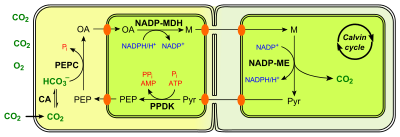C4 Pathway or the Hatch–Slack pathway
C4 carbon fixation or the Hatch–Slack pathway is a photosynthetic process in some plants. It is the first step in extracting carbon from carbon dioxide to be able to use it in sugar and other biomolecules. It is one of three known processes for carbon fixation. "C4" refers to the four-carbon molecule that is the first product of this type of carbon fixation.
C4 fixation is an elaboration of the more common C3 carbon fixation and is believed to have evolved more recently. C4 overcomes the tendency of the enzyme RuBisCO to wastefully fix oxygen rather than carbon dioxide in the process of photorespiration. This is achieved by ensuring that RuBisCO works in an environment where there is a lot of carbon dioxide and very little oxygen. CO2 is shuttled via malate or aspartate from mesophyll cells to bundle-sheath cells. In these bundle-sheath cells CO2 is released by decarboxylation of the malate. C4plants use PEP carboxylase to capture more CO2 in the mesophyll cells. PEP carboxylase (three carbons) binds to CO2 to make oxaloacetic acid (OAA). OAA then makes malate (four carbons). Malate enters bundle sheath cells and releases the CO2. These additional steps, however, require more energy in the form of ATP. Using this extra energy, C4 plants are able to more efficiently fix carbon in drought, high temperatures, and limitations of nitrogen or CO2. Since the more common C3 pathway does not require this extra energy, it is more efficient in the other conditions.
The naming Hatch–Slack pathway is in honor of Marshall Davidson Hatch and C. R. Slack, who elucidated it in Australia in 1966.
The first experiments indicating that some plants do not use C3 carbon fixation but instead produce malate and aspartate in the first step of carbon fixation were done in the 1950s and early 1960s by Hugo P. Kortschak[2] and Yuri Karpilov.[3] The C4 pathway was elucidated by Marshall Davidson Hatch and C. R. Slack, in Australia, in 1966; it is sometimes called the Hatch-Slack pathway.[1]
In C3 plants, the first step in the light-independent reactions of photosynthesis involves the fixation of CO2 by the enzyme RuBisCO into 3-phosphoglycerate. However, due to the dual carboxylase and oxygenase activity of RuBisCo, some part of the substrate is oxidized rather than carboxylated, resulting in loss of substrate and consumption of energy, in what is known as photorespiration.
In order to bypass the photorespiration pathway, C4 plants have developed a mechanism to efficiently deliver CO2 to the RuBisCO enzyme. They use their specific leaf anatomy where chloroplasts exist not only in the mesophyll cells in the outer part of their leaves but in the bundle sheath cells as well. Instead of direct fixation to RuBisCO in the Calvin cycle, CO2 is incorporated into a four-carbon organic acid, which has the ability to regenerate CO2 in the chloroplasts of the bundle sheath cells. Bundle sheath cells can then use this CO2 to generate carbohydrates by the conventional C3 pathway.
The first step in the pathway is the conversion of pyruvate to phosphoenolpyruvate (PEP), by the enzyme pyruvate orthophosphate dikinase. This reaction requires inorganic phosphate and ATP plus pyruvate, producing phosphoenolpyruvate, AMP, and inorganic pyrophosphate (PPi). The next step is the fixation of CO2into oxaloacetate by the enzyme PEP carboxylase. Both of these steps occur in the mesophyll cells:
- pyruvate + Pi + ATP → PEP + AMP + PPi
- PEP + CO2 → oxaloacetate
PEP carboxylase has a lower Km for HCO−
3 — and, hence, higher affinity — than RuBisCO. Furthermore, O2 is a very poor substrate for this enzyme. Thus, at relatively low concentrations of CO2, most CO2 will be fixed by this pathway.
The product is usually converted to malate, a simple organic compound, which is transported to the bundle-sheath cells surrounding a nearby vein. Here, it is decarboxylated to produce CO2 and pyruvate. The CO2 now enters the Calvin cycle and the pyruvate is transported back to the mesophyll cell.
Since every CO2 molecule has to be fixed twice, first by four-carbon organic acid and second by RuBisCO, the C4 pathway uses more energy than the C3 pathway. The C3 pathway requires 18 molecules of ATP for the synthesis of one molecule of glucose, whereas the C4 pathway requires 30 molecules of ATP. This energy debt is more than paid for by avoiding losing more than half of photosynthetic carbon in photorespiration as occurs in some tropical plants,[citation needed] making it an adaptive mechanism for minimizing the loss.
There are several variants of this pathway:
- The four-carbon acid transported from mesophyll cells may be malate, as above, or aspartate.
- The three-carbon acid transported back from bundle-sheath cells may be pyruvate, as above, or alanine.
- The enzyme that catalyses decarboxylation in bundle-sheath cells differs. In maize and sugarcane, the enzyme is NADP-malic enzyme; in millet, it is NAD-malic enzyme; and, in Panicum maximum, it is PEP carboxykinase.



